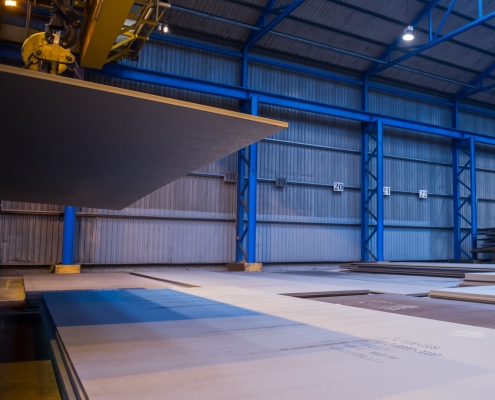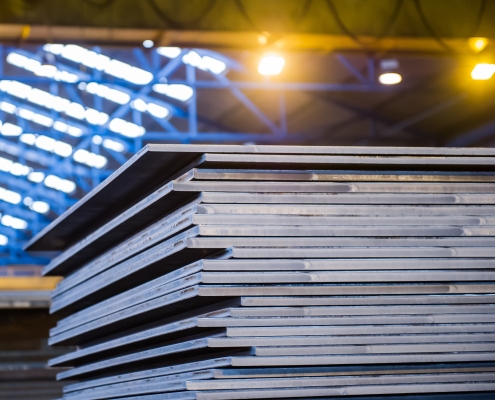Welcome to Future Energy Steel’s premier selection of steel plates tailored for shipbuilding applications, meticulously crafted to meet stringent industry standards such as ABS/LR/GL/DNV/BV/CCS/NK/RINA, etc. Our comprehensive range includes various grades designed to withstand harsh marine environments, ensuring exceptional strength, corrosion resistance, and weldability. Key features of our plates include precise dimensional accuracy, excellent surface finish, and superior mechanical properties, crucial for the construction of reliable and efficient vessels. We offer comprehensive services including customized cutting, testing, and efficient logistics solutions, supported by our unwavering commitment to quality assurance. Whether for commercial vessels, naval ships, or offshore platforms, Energy Steel’s shipbuilding steel plates ensure durability and safety at sea, making us a trusted partner in maritime engineering projects worldwide. For more details, please contact [email protected].
FAQs
What Are Steel Plates for Shipbuilding?
Steel plates for shipbuilding are specialized structural steel plates used in the construction of ships, offshore platforms, and other marine structures. These plates are designed to withstand high levels of mechanical stress and harsh maritime environments, including saltwater corrosion and extreme temperatures. Key characteristics and applications of steel plates for shipbuilding include:
- High Strength: Shipbuilding steel plates are characterized by high tensile strength and yield strength, which are essential for withstanding the structural loads encountered at sea and in heavy seas.
- Corrosion Resistance: Steel plates for shipbuilding are often made with alloyed or coated materials to enhance corrosion resistance and protect against marine environments, including seawater, moisture, and atmospheric conditions.
- Weldability: Excellent weldability is crucial for shipbuilding steel plates to facilitate efficient and reliable welding during ship assembly and repair. Strong weld joints are essential for maintaining the structural integrity of the ship under dynamic and fluctuating loads.
- Formability: Shipbuilding steel plates must have good formability to be shaped into various hull and structural components, such as plates, frames, and bulkheads, during ship construction.
- Low Temperature Toughness: Steel plates used in shipbuilding should maintain their mechanical properties and toughness at low temperatures to ensure reliable performance in cold climates and during Arctic navigation.
- Conformance to Standards: Shipbuilding steel plates must comply with international standards and classification societies’ rules, such as those set by the International Association of Classification Societies (IACS) and organizations like the American Bureau of Shipping (ABS), Lloyd’s Register of Shipping (LR), and DNV GL.
- Applications: Steel plates for shipbuilding are used in various ship components, including hulls, decks, superstructures, and other critical structural elements. They contribute to the overall strength, stability, and safety of the vessel.
How Many Types of Shipbuilding Steel Plates?
Shipbuilding steel plates are classified into several types based on their specific characteristics and intended applications in ship construction. The types of shipbuilding steel plates can vary depending on factors such as material composition, mechanical properties, and classification society standards. Here are the main types of shipbuilding steel plates:
- General Strength Shipbuilding Steel Plates: These plates are typically categorized as Grade A, B, D, and E according to their yield strength. They are used for the general construction of ship hulls and other structural components where moderate strength and good weldability are required.
- High Strength Shipbuilding Steel Plates: High-strength shipbuilding steel plates are designed to provide higher yield strength and tensile strength than general strength plates. Grades like AH32, DH32, EH32, AH36, DH36, and EH36 fall into this category. They are used in the construction of offshore platforms and vessels operating in harsh marine environments.
- Ultra-High Strength Shipbuilding Steel Plates: These plates are designed to provide exceptional strength and toughness, suitable for extreme conditions encountered in Arctic or deep-sea operations. Grades such as AH40, DH40, and EH40 are examples of ultra-high-strength shipbuilding steel plates.
- Corrosion-Resistant Shipbuilding Steel Plates: Some shipbuilding applications require steel plates with enhanced corrosion resistance to withstand exposure to seawater and marine environments. Special alloy compositions or coatings are used to achieve improved corrosion resistance.
- Offshore and Marine Structural Steel Plates: These plates are used in the construction of offshore oil platforms, floating production storage and offloading (FPSO) vessels, and other marine structures. They may have specific requirements for strength, toughness, and weldability to meet offshore industry standards.
- Classified and Certified Plates: Shipbuilding steel plates must comply with classification society rules and international standards, such as those set by ABS, DNV GL, LR, BV, and others. Plates are certified by these societies based on their material properties, manufacturing process, and compliance with safety and quality standards.
What Are the Standards for Shipbuilding Plates?
Shipbuilding plates must adhere to stringent standards set by classification societies and international organizations to ensure safety, reliability, and performance in marine environments. The main standards and classifications applicable to shipbuilding plates include:
- International Association of Classification Societies (IACS):
- IACS is an organization composed of twelve leading classification societies worldwide, including ABS, DNV GL, LR, BV, and others. They establish rules and standards for the design, construction, and maintenance of ships and marine structures.
- American Bureau of Shipping (ABS):
- ABS is one of the leading classification societies globally, providing standards and certification for shipbuilding materials and structures. Their rules cover requirements for steel plates used in ship hulls, superstructures, and critical components.
- Det Norske Veritas Germanischer Lloyd (DNV GL):
- DNV GL offers classification, certification, and advisory services for the maritime industry. Their standards ensure the integrity and safety of shipbuilding materials, including steel plates, according to international regulations.
- Lloyd’s Register of Shipping (LR):
- LR is a classification society that provides standards and rules for the design, construction, and maintenance of ships and offshore structures. Their standards cover the quality, performance, and certification of shipbuilding steel plates.
- Bureau Veritas (BV):
- BV is a classification society offering classification, certification, and technical advisory services in the maritime and offshore sectors. Their standards ensure compliance with safety, environmental, and quality requirements for shipbuilding materials.
- ASTM International:
- ASTM standards provide specifications for steel plates used in shipbuilding and marine applications. ASTM A131/A131M covers structural steel plates for ships, while ASTM A514/A514M and ASTM A572/A572M provide standards for high-strength and low-alloy structural steels used in marine structures.
- European Norm (EN):
- EN standards, such as EN 10025 and EN 10225, provide specifications for structural steels and weldable structural steels for offshore structures, respectively. These standards ensure compliance with European Union regulations and international maritime requirements.
- Japanese Industrial Standards (JIS):
- JIS standards, including JIS G3106 and JIS G3136, provide specifications for carbon and low-alloy steel plates used in shipbuilding and marine structures. These standards are recognized internationally and used by shipbuilders worldwide.
Are the Technical Requirements for Shipbuilding Plates Critical?
Yes, the technical requirements for shipbuilding plates are critically important due to the rigorous operational conditions and safety considerations in marine environments. Several key reasons highlight the critical nature of these requirements:
- Safety and Structural Integrity: Ships and marine structures are subjected to dynamic loads, including wave impacts, vibrations, and varying environmental conditions. Shipbuilding plates must possess specific mechanical properties, such as high strength, toughness, and ductility, to ensure the structural integrity of the vessel and withstand these operational stresses.
- Reliability and Performance: Shipbuilding plates must meet stringent requirements for weldability, formability, and corrosion resistance to ensure reliable performance throughout the vessel’s operational lifespan. Proper selection and adherence to technical standards help prevent structural failures, leaks, and other operational hazards.
- Compliance with Regulations: Ships and marine structures are subject to classification society rules, international regulations (such as SOLAS), and national maritime laws that mandate adherence to specific technical standards for construction materials. Compliance ensures that vessels meet safety, environmental, and operational standards set by regulatory bodies.
- Operational Efficiency: Technical requirements for shipbuilding plates contribute to the operational efficiency of vessels by optimizing weight, stability, and fuel consumption. Plates with appropriate strength-to-weight ratios and corrosion resistance minimize maintenance requirements and operational downtime.
- Environmental Considerations: Shipbuilding plates must often adhere to environmental standards, including requirements for materials that minimize environmental impact during construction, operation, and eventual decommissioning of vessels.
- Certification and Classification: Classification societies certify shipbuilding plates based on their compliance with technical requirements and standards. Certification ensures that plates meet quality assurance criteria, undergo rigorous testing, and are suitable for use in shipbuilding applications.
Is Impact Test Required and What is the Testing Temperature for Shipbuilding Plates?
Yes, impact testing is often required for shipbuilding plates to assess their toughness and ability to withstand sudden impact loads, which is crucial for ensuring the safety and integrity of ships and marine structures. The testing temperature for impact tests on shipbuilding plates varies depending on the specific material grade and applicable standards.
Generally, the impact test temperature is specified to simulate the conditions the ship or marine structure may encounter during service. Commonly used impact test temperatures for shipbuilding plates include:
- Room Temperature (RT): Impact tests conducted at room temperature (typically around 20°C or 68°F) assess the baseline toughness of the material under normal operating conditions.
- Low Temperature (LT): Impact tests at low temperatures assess the material’s toughness and ductility under cold climate conditions, such as -20°C (-4°F) or lower. This is particularly important for vessels operating in Arctic regions or cold seas.
- Subzero Temperature (ST): Some shipbuilding grades, especially those designed for extremely cold environments, may require impact tests at even lower temperatures, such as -40°C (-40°F) or -60°C (-76°F).
The specific testing temperature and requirements for impact testing are typically defined by classification societies (e.g., ABS, DNV GL, LR), international standards (e.g., ASTM, EN), or specific project specifications. These standards ensure that shipbuilding plates demonstrate adequate toughness and resistance to brittle fracture under different operational conditions.
Impact testing is conducted using standardized methods, such as Charpy V-notch (CVN) or Izod tests, where a notched specimen is struck by a swinging pendulum, and the energy absorbed by the specimen during fracture is measured. The results of impact tests help assess the material’s behavior under sudden loading conditions and ensure it meets the required toughness and safety standards for shipbuilding applications.



